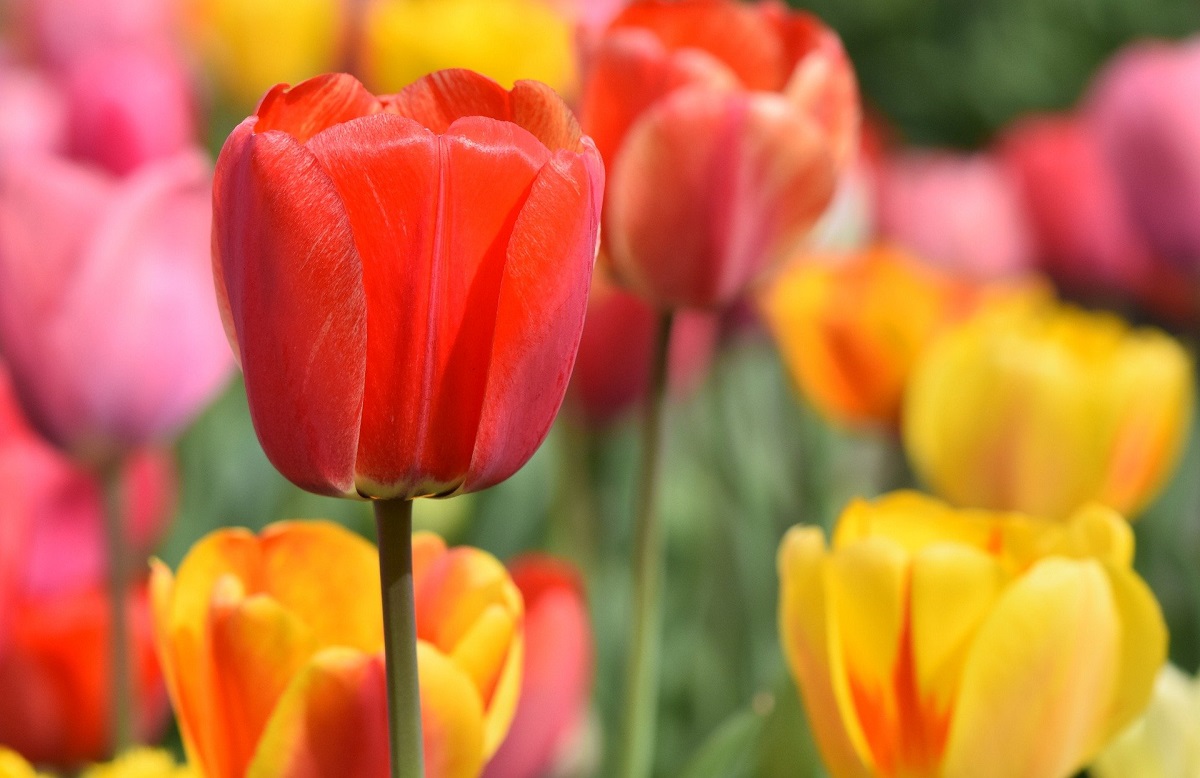
Tulips are one of the most beloved and well-known flowers around the world. With their vibrant colors and elegant petals, these flowers have captured the hearts of both gardeners and flower enthusiasts alike. But beyond their aesthetic appeal, tulips also have a fascinating history and several intriguing facts associated with them. In this article, we will uncover 15 astounding facts about tulips that will leave you even more enamored with these beautiful blooms. From their origin in the Ottoman Empire to their significant role in Dutch culture, there is much to discover about the captivating world of tulips. So, prepare to be amazed as we delve into the mesmerizing secrets behind these beloved flowers.
Key Takeaways:
- Tulips originated in the Ottoman Empire and were later popularized in the Netherlands, symbolizing love and new beginnings. They come in various colors and can continue to bloom for years, captivating bees and butterflies.
- The Netherlands is the largest tulip producer, and tulip bulbs were once more valuable than gold during “Tulip Mania.” With unique patterns and edible petals, tulips bring beauty and fragrance to gardens and floral arrangements.
Tulips originated in the Ottoman Empire.
Tulips are not native to the Netherlands, as is commonly believed. They were originally cultivated in the Ottoman Empire, which is now modern-day Turkey. In the 16th century, tulips were brought to the Netherlands and gained popularity, eventually becoming a symbol of Dutch culture.
Tulips come in a variety of colors.
One of the fascinating aspects of tulips is their wide range of colors. From vibrant reds, pinks, and purples to soft pastels and even striking black, there is a tulip color to suit every preference. This diversity adds to the allure of these beautiful flowers.
The Netherlands is the largest producer of tulips in the world.
When it comes to tulip production, the Netherlands takes the lead. The country’s favorable climate and fertile soil make it an ideal location for cultivating tulips. It produces an astonishing number of tulip bulbs each year, exporting them to various parts of the globe.
Tulips are not just for spring.
While tulips are often associated with spring, there are also varieties that bloom in summer and fall. By choosing different types of tulips, you can enjoy their stunning beauty throughout the year, bringing color to your garden or home during different seasons.
Tulips symbolize love and affection.
Tulips have long been associated with love and affection. In the language of flowers, red tulips represent passionate love, while pink tulips convey affection and care. They are the perfect choice for expressing heartfelt emotions to your loved ones.
Tulips continue to grow after being cut.
If you cut a tulip and place it in a vase of water, it will continue to grow. The stem will elongate, and the flower will open up further, displaying its full beauty. This unique characteristic makes tulips a popular choice for floral arrangements and bouquets.
Tulips can be highly fragrant.
While not all tulips emit a fragrance, some varieties have a delightful scent. The fragrance can range from sweet and floral to spicy and even slightly citrusy. Consider selecting fragrant tulips for your garden or indoor arrangements to enjoy their enchanting aroma.
Tulip bulbs were once more valuable than gold.
During the 17th century, tulip bulbs reached incredible levels of popularity in the Netherlands. People were willing to pay exorbitant prices for rare and exotic varieties, often more than the cost of gold. This period, known as “Tulip Mania,” was characterized by speculative trading of tulip bulbs.
Tulips can have unique and fascinating patterns.
Some tulips exhibit mesmerizing patterns on their petals, such as streaks, flames, or intricate brushstrokes. These patterns are known as “breaks.” The unpredictability of these patterns makes each tulip a work of art, nature’s masterpiece.
Tulips are edible.
The petals of tulips are not only visually appealing but also edible. They have a mild, slightly sweet taste and can be used as a decorative addition to salads, desserts, and even infused into beverages like teas and cocktails. However, it’s essential to ensure that the tulips are grown without chemicals and are safe for consumption.
Tulips can symbolize new beginnings.
With their vibrant colors and the arrival of spring, tulips often symbolize new beginnings and fresh starts. They are a great reminder to embrace change, growth, and the opportunities that come with a new phase in life.
Tulips can continue to bloom for several years.
While some flowers have a short lifespan, tulips can bring beauty year after year. By properly caring for the bulbs and providing them with the necessary conditions, tulips can bloom for multiple seasons, bringing joy and color to your garden.
Tulips were highly sought after during the Dutch Golden Age.
In the 17th century, tulips were not only valued for their beauty but also as a status symbol during the Dutch Golden Age. People competed to have the rarest and most beautiful tulips in their gardens, showcasing their wealth and taste to society.
Tulips can capture the attention of bees and butterflies.
Tulips, with their bright colors and nectar-filled cups, attract various pollinators such as bees and butterflies. These insects play a crucial role in the pollination process, ensuring the survival and propagation of tulip plants and other flowering species.
Tulips are versatile and can be grown in various climates.
Despite being associated with the colder climate of the Netherlands, tulips are surprisingly adaptable. With the right care and selection of suitable varieties, they can thrive in different climates and regions around the world, adding beauty and charm to diverse landscapes.
Conclusion
Tulips are truly fascinating flowers that captivate the hearts of many. From their rich history to their stunning varieties, there is so much to learn about these beautiful blooms. Whether you’re a fan of gardening or simply appreciate the beauty of nature, exploring the world of tulips will surely leave you in awe.
With their vibrant colors and unique shapes, tulips have become a symbol of love, beauty, and elegance. As you dive deeper into the world of tulips, you’ll discover a wealth of knowledge about their cultivation, care, and cultural significance.
So the next time you come across a tulip, take a moment to appreciate its beauty and remember these astounding facts. Whether you’re planting them in your garden or admiring them in a bouquet, tulips will continue to amaze and inspire for generations to come.
FAQs
1. How long do tulips bloom?
Tulips typically bloom for 1-2 weeks, depending on the variety and weather conditions. However, some early and late blooming tulips can extend the blooming period.
2. Do tulips come back every year?
Yes, most tulips are perennial and will come back year after year if planted in the right conditions. Regularly fertilizing and providing proper care can ensure their return.
3. Can I plant tulips in pots?
Absolutely! Tulips can be grown in pots or containers. Make sure to use well-draining soil and provide adequate sunlight for optimal growth.
4. When is the best time to plant tulip bulbs?
Tulip bulbs should be planted in the fall, about 6-8 weeks before the ground freezes. This allows them to establish roots before winter and bloom in the spring.
5. How deep should I plant tulip bulbs?
Tulip bulbs should be planted about 6-8 inches deep, with the pointed side facing upwards. Be sure to space them at least 4-6 inches apart for proper growth.
6. Can tulips grow in hot climates?
Tulips are native to cooler climates, so they may struggle in hot regions. However, you can grow them as annuals or use techniques like pre-chilling the bulbs to mimic colder conditions.
7. Are there different types of tulips?
Yes, there are over 3,000 registered tulip varieties. They come in various colors, including single and double blooms, fringed edges, parrot-like petals, and more.
8. How do I keep tulips from drooping?
To prevent tulips from drooping, cut the stems at an angle and place them in deep water. You can also wrap the stems tightly in newspaper and let them hydrate for a few hours.
9. Can I force tulips to bloom indoors?
Yes, you can force tulips to bloom indoors by planting pre-chilled bulbs in pots and keeping them in a cool, dark place for several weeks. Once they develop roots, bring them into a bright room to enjoy their colorful display.
10. Are tulips toxic to pets?
Yes, tulips contain toxins that can be harmful to pets if ingested. Keep them out of reach or consider using pet-safe alternatives in your garden.
Was this page helpful?
Our commitment to delivering trustworthy and engaging content is at the heart of what we do. Each fact on our site is contributed by real users like you, bringing a wealth of diverse insights and information. To ensure the highest standards of accuracy and reliability, our dedicated editors meticulously review each submission. This process guarantees that the facts we share are not only fascinating but also credible. Trust in our commitment to quality and authenticity as you explore and learn with us.


